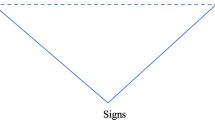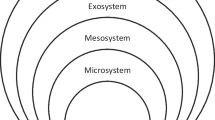Abstract
Ivã Gurgel, Mauricio Pietrocola, and Graciella Watanabe expand upon the existing literature, which links identity and science engagement. Specifically, the authors focus on ways in which the cultural identities of students relate to their engagement in physics. In doing so, Gurgel, Pietrocola, and Watanabe further build upon the idea that one’s identity is not immutable, but rather is continually re-constituted throughout life. Employing the lens of ontological authenticity, the authors use three interventions with the purpose of revealing the intersection of students’ cultural identity and science. In this paper I extend the dialogue on how we can further explore the link between identity and science engagement, starting first with a consideration of student identity and its significance, before extending this inquiry into the specific field of science.
Similar content being viewed by others
References
Bosch, M., & Gascón, J. (2006). Twenty-five years of the didactic transposition. ICMI Bulletin, 58, 51–65.
Edelson, D.C. (1998). Realising authentic science learning through the adaptation of scientific practice. In K. Tobin & B. Fraser (Eds.), International handbook of science education (Vol. 2, pp. 317–333). doi:10.1007/978-94-011-4940-2_19
Gee, J. P. (1990). Social linguistics and literacies: Ideology in discourses, critical perspectives on literacy and education. Bristol, PA: Taylor and Frances. doi:10.4324/9780203814444.
Giddens, A. (1991). Modernity and self-identity: Self and society in the late modern age. Stanford, CA: Stanford University Press.
Gutiérrez, K. D., & Rogoff, B. (2003). Cultural ways of learning: Individual traits or repertoires of practice. Educational Researcher, 32(5), 19–25. doi:10.3102/0013189x032005019.
Moje, E. B., Ciechanowski, K. M., Kramer, K., Ellis, L., Carrillo, R., & Collazo, T. (2004). Working toward third space in content area literacy: An examination of everyday funds of knowledge and discourse. Reading Research Quarterly, 39(1), 38–70. doi:10.1598/rrq.39.1.4.
Moll, L. C., & Greenberg, J. B. (1990). Creating zones of possibilities: Combining social contexts for instruction. In L. C. Moll (Ed.), Vygotsky and education: Instructional implications and applications of sociohistorical psychology (pp. 319–348). Cambridge: Cambridge University Press. doi:10.1017/cbo9781139173674.016.
Moll, L., Amanti, C., Neff, D., & González, N. (1992). Funds of knowledge for teaching: Using a qualitative approach to connect homes and classrooms. Theory Into Practice, 31(2), 132–141. doi:10.1080/00405849209543534.
National Committee on Science Education Standards and Assessment, & National Research Council. (1996). National science education standards. National Academy Press.
Office of English Languages Learners. (2013). Demographic report. New York City Department of Education’s. Division of Students with Disabilities and English Language Learners. http://schools.nyc.gov/NR/rdonlyres/FD5EB945-5C27-44F8-BE4B-E4C65D7176F8/0/2013DemographicReport_june2013_revised.pdf
Schutz, A., & Luckman, T. (1971). Structures of the life world. Portsmouth, NH: Heineman. doi:10.1007/978-94-015-3456-7_7.
Seiler, G. (2001). Reversing the “standard” direction: Science emerging from the lives of African American students. Journal of Research in Science Teaching, 38(9), 1000–1014. doi:10.1002/tea.1044.
Sewell, W. H. (2005). Logics of history: Social theory and social transformation. Chicago: University of Chicago Press. doi:10.7208/chicago/9780226749198.001.0001.
Tsui, L. (2007). Effective strategies to increase diversity in STEM fields: A review of the research literature. The Journal of Negro Education, 76(4), 555–581.
Turner, J. H. (2013). Contemporary sociological theory. United States: Sage Publications.
Vygotsky, L. S. (1978). Mind in Society: The development of higher pyshological processes. Cambridge, MA: Harvard University Press.
Author information
Authors and Affiliations
Corresponding author
Additional information
Lead Editor: K. Tobin.
This review essay addresses issues raised in Ivã Gurgel, Mauricio Pietrocola, Graciella Watanabe’s paper entitled: The role of cultural identity as a learning factor in physics: a discussion through the role of science in Brazil. Doi:10.1007/s11422-014-9580-5.
Rights and permissions
About this article
Cite this article
Strong, L. The intersection of identity, culture and science engagement. Cult Stud of Sci Educ 11, 379–385 (2016). https://doi.org/10.1007/s11422-015-9680-x
Received:
Accepted:
Published:
Issue Date:
DOI: https://doi.org/10.1007/s11422-015-9680-x




